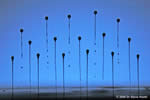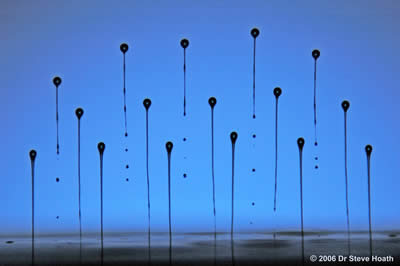University of Cambridge Epson Photography Competition
 Epson UK Press Release
Epson UK Press Release
Nanohand, lasered textiles and injket micro-drops win Epson Photography Competition at the University of Cambridge Department of Engineering
July 6th 2006 - The unsuspected beauty of images from engineering is revealed today by the winners of the University of Cambridge Epson Photography Competition at the Department of Engineering. The Department of Engineering’s annual photography contest was started two years ago and is now well established with the winners having their pictures reproduced in the technical and popular press around the world. The competition is open to all staff and students in the Department. The winning photograph shows what your inkjet printer is doing, if you could only see the movement of the ink drops, moving at 6 metres per second as they hurtle towards the page. Taken by Dr Steve Hoath, a Research Associate at the Inkjet Research Centre at the Department for Engineering, it is entitled ‘Tails from the Nozzle Bank’.
In second place, student Laura Harrison’s untitled photo is of prototypes of elastic chain-link designs. She is investigating the potential for using ‘Selective Laser Sintering’ processes for new garment manufacturing techniques. A chain-link structure enables the creation of flexible textile structures from rigid materials. Laura has recently completed the Manufacturing Engineering Tripos at the Institute for Manufacturing and next year will be studying Industrial Design Engineering at the Royal College of Art.
In third place is a remarkable image which shows a ball only ~65µm across captured in the cage of a microgripper. This device is suitable for trapping and holding biological specimens such as cells without applying a force directly on it, thus avoiding potential damage to the cell. The image was taken by Dr Jack Luo and Dr Yong Qing Fu and is entitled ‘Nanohand and its captured ball’. Dr Jack Luo develops microsystems for microelectronics, medical and biological applications, and acoustic wave based biosensors to detect cancers at molecule level. Dr Yong Qing Fu’s research covers micro-electro-mechanical systems, shape memory alloy, surface science and thin films. He has developed several types of TiNi (Tiny Internet Interfaces) thin film-based microactuators for biomedical applications.
The panel of judges includes Phillip King RA, sculptor and President of the Royal Academy 1999; Professor Keith Glover, Head of the Department of Engineering, University of Cambridge, Roberto Cipolla, Professor of Information Engineering, Dr Allan McRobie, and Philip Guildford of the Department of Engineering, University of Cambridge. Previous winners have included Ghim Wei Ho’s iconic image of a ‘Nano flower’, which won the competition in 2004.
Epson kindly sponsored the 2006 Engineering Photo Competition at the University of Cambridge, and provided £1000 worth of professional printers as prizes.
About Epson
Epson is a global leader in imaging products including printers, 3LCD projectors and small- and medium-sized LCDs. With an innovative and creative culture, Epson is dedicated to exceeding the vision and expectations of customers worldwide with products known for their superior quality, functionality, compactness and energy efficiency.
Epson is a network of 90,701 employees in 120 companies around the world, and is proud of its ongoing contributions to the global environment and to the communities in which it is located. Led by the Japan-based Seiko Epson Corp., the Group had consolidated sales of 1549.5 billion yen in fiscal 2005.

